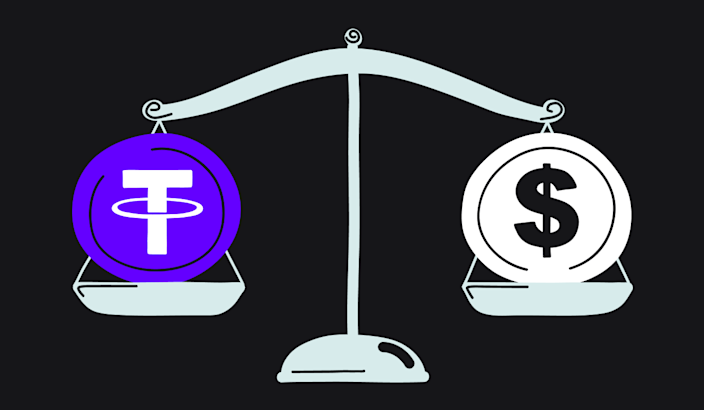What is a stablecoin?

For many, the volatility of cryptocurrencies like Bitcoin or Ethereum makes it repelling to store your wealth in or use as a medium of exchange in your everyday life. Imagine paying 10,000 Bitcoin for two large pizzas, and then realize that twelve years later those pizzas cost you around 300 million USD in alternative cost of just storing your Bitcoin. Or imagine being a merchant that accepts crypto as a payment method, you need to cover all of your expenses and cannot afford to accept a volatile currency, since this would expose you to a significant currency risk. Here is where a stablecoin fills the gap, since the price of a stablecoin is stable and non volatile.
So, what is a stablecoin? In short, a stable coin is a cryptocurrencies that is pegged to a stable asset. This is usually some kind of fiat currency or monetary metal as gold. The price of the stablecoin correlates with an underlying asset. As for instance, a USD pegged stable coin has a ratio of 1/1 with the USD i.e. one stablecoin has (almost) the same price as one USD. This makes stablecoins’ price predictable and thus preferable cryptocurrency for everyday transactions.
How does it work?
As mentioned above, a stablecoin is different from cryptocurrencies like Bitcoin and Ethereum since it´s value is dependent on the underlying asset that it´s pegged against. With that said, a stablecoin is different from regular Fiat currencies like the dollar since it exists on a public blockchain. So, a stablecoin has the same characteristics as a cryptocurrency i.e. immutable, peer to peer and are transactional without a third party intermediary, but have the price stability connected to the underlying asset.
Why does it have value?
So, with the above explanation, why is stablecoins important and does it have value? First, since stablecoins has the same characteristics as Bitcoin and Ethereum in the case that it is immutable, decentralized and transactional without a third party intermediary, these currencies bring great value for people that are living under cruel financial circumstances, i.e. hyperinflation, bank corruption etc. For them to get hold of a stable fiat currency like the dollar or euro but via crypto transactions, creates great value.
Apart from being a great store of value or means of exchange for people that live under financial oppression, a stablecoin could be used for more situations. One use case that is very common within the crypto space, is to use stablecoins in DeFi protocols (insert link to DeFi). Since the value of a stablecoin is stable and the rates in DeFi often are better than in the regular financial landscape, this use case has been very attractive for people that are familiar with the crypto landscape.
Different type of stablecoins
For a stablecoin to be pegged against a stable asset, it needs to be backed by another type of asset, this could be Fiat, gold, crypto or other financial assets. This can be done in different ways, you can either have off-chain collateral or on-chain collateral, there is also another type that is called algorithmic stablecoins, these types is be explained below.
Off-chain
An off-chain collateralized stablecoin holds its collateral in separate custody i.e. not on the blockchain, it could be a bank account or physical assets like gold. So for instance, if the market capitalization of that stablecoin is €50 000, the company that issues that stable coin, needs to hold assets worth €50 000 in assets. Examples of Stablecoins that are off-chain collateralized are USDT(Tether) or USDC(Circle).
On-chain
An on-chain collateralized stablecoin is one that exists purely on the blockchain and is recorded in a decentralized manner and does not need a centralized custodian or issuer.
In order to mint new stablecoins, you need to put in collateral in terms of cryptocurrencies where the most common crypto is Ether. In order to mitigate the price fluctuation that is related to Ether, the protocol uses overcollateralized backing in order to mitigate the risk of depegging the stablecoin from the pegged asset class. An example of this type of stablecoin is DAI which is issued by the protocol MakerDao.
Algorithmic
An algorithmic stable coin is purley decentralized and not centrally backed by any off-chain assets such as Fiat, Gold or other financial assets. The real difference between an algorithmic stable coin and an on-chain collateralized stable coin, is that the on-chain collateralized stablecoin(like DAI) is over collateralized, whereas algorithmic stablecoins are not.
What does “algorithmic” mean? By algorithmic it means that it follows a predetermined command that is set by code with a smart contract, it executes automatically when a certain criteria has been fulfilled. The algorithmic stablecoin is backed by another crypto asset that acts as the reserve that backs the price of the stablecoin. One example of this is UST/Terra Luna, UST is the stablecoin and Terra Luna is the crypto asset that backs UST. One problem with algorithmic stablecoins is that they often are undercollateralized and are dependent on the price of the backing crypto asset such as Terra Luna. So, for instance, if a large sell off happens in UST, that would trigger a depeg action which must be backed by minting new Terra Luna. So in its essence, UST is backed by market expectation that the underlying asset will appreciate in value. This is a more risky approach to obtain stability in a stablecoin, it can succeed, but it can also, as we have seen, lead to substantial crashes in both the stablecoin and the backing crypto asset.